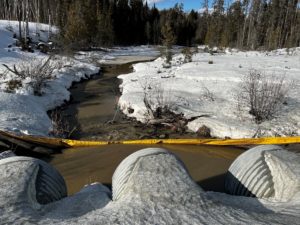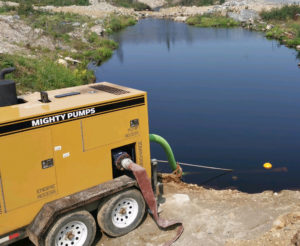Are you ready for this years Freshet?
April 14, 2023
What is Freshet?
Freshet also known as spring runoff is an annual high-water event that is the result of snow and ice melting. This increase of water flow makes it’s way downstream, resulting in higher water levels in our rivers, lakes, ponds, runoffs, and retention ponds. Every freshet will bring with it vegetation, sediment, and organic material. It is important to understand the conditions that may effect your area and be prepared for the freshet. Having an effective water management plan is the best way to be prepared for the spring deluge.
Factors to consider
When getting ready for spring, the amount of snow that has accumulated over the winter months is one factor to consider. Not just in your area but also where the water may flow from, this can include mountain and hill regions, or just upstream of a nearby river. In Alberta, the average snowfall can range from 80 to over 200 centimeters of snow. The density of the snow can also affect the amount of water the snow will melt into. A general guide is every 10 inches of snow will turn into 1 inch of water, 1 acre of snow 10 inches deep will turn into over 27,000 gallons of water. Temperature can also affect the freshet as a warm spring will melt the snow faster than a cold spring. If the ground remains frozen none of this melting snow will be able to get absorbed into the soil and will flow downstream.
This flow down stream will bring the vegetation, sediment, and organic material with it. Dirt and mud can get into the water along with larger organic material such as branches, leaves and log. The Debris can cause issues as it moves downstream, building up and possibly creating a dam and restricting the flow of water. This build up of water can cause damage to the surrounding area or cause the flow of water to deviate from its natural path and create a flood. The flood may run through an area more susceptible to damage from the flowing water. Using a turbidity screen upstream can catch the sediment and be easier to clean then the potential of a dam causing issues downstream.
Streams will typically run to ponds, lakes, and retention ponds. They allow water to build up without the downstream flow flooding and damaging an area. However, some conditions cause these bodies of water to accumulate more water then they can handle. Your water management plan should address what to do when water storage has hit its limit. A dewatering pumping system can be used to move this water before it becomes a problem. Not all pumps are built the same, some can only move fluids while some are built to move the solids that are present in the water. A water management professional will be able to address the issues that come with freshet and the solutions you need to get through the spring season.
What can you do?
Be proactive and not reactive when it comes to freshet. Keeping your equipment and critical infrastructure clear of the downstream flow is key to keeping them safe. If these downstream areas need equipment makes sure your water management plan will keep that equipment safe. Bypassing a flow of water can keep these areas dry. This can require a large volume of water to be moved fast and may require to have multiple pumps working in unison. A water management professional will be able to set these systems up for a optimal solution.
Canada Pump and Power has a large variety of solutions for moving water and handling freshet. Every size of pump is available for the many different scenarios. Our engineering team specializes in water management and can create optimal solutions for any pumping job. CPP can provide personnel to operate these systems to the ensure success and getting the job done right. If water retention is an issue, Canada Pump and Power can dredge your pond, lakes, and retention ponds for additional capacity.


